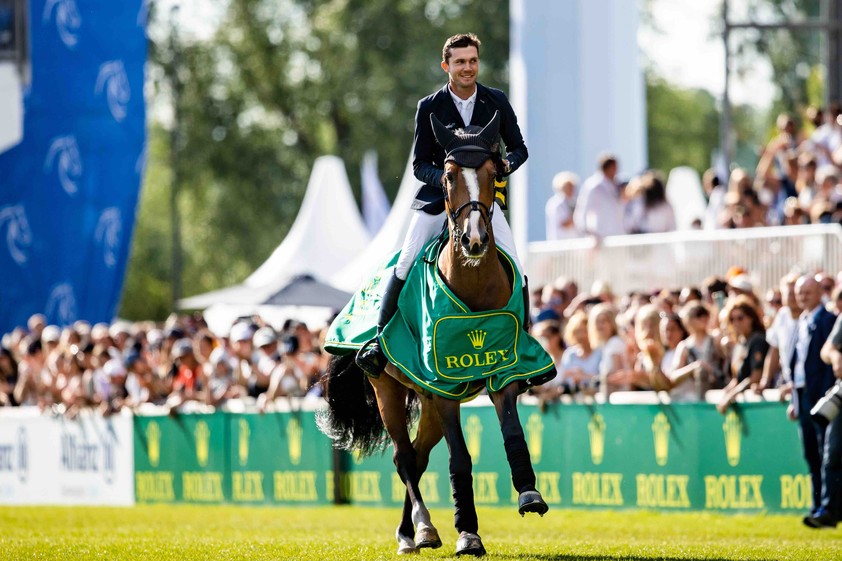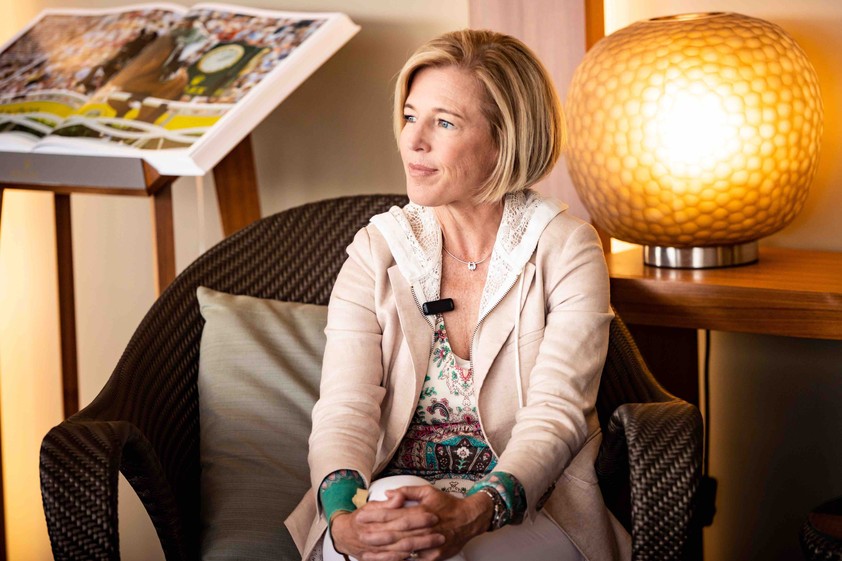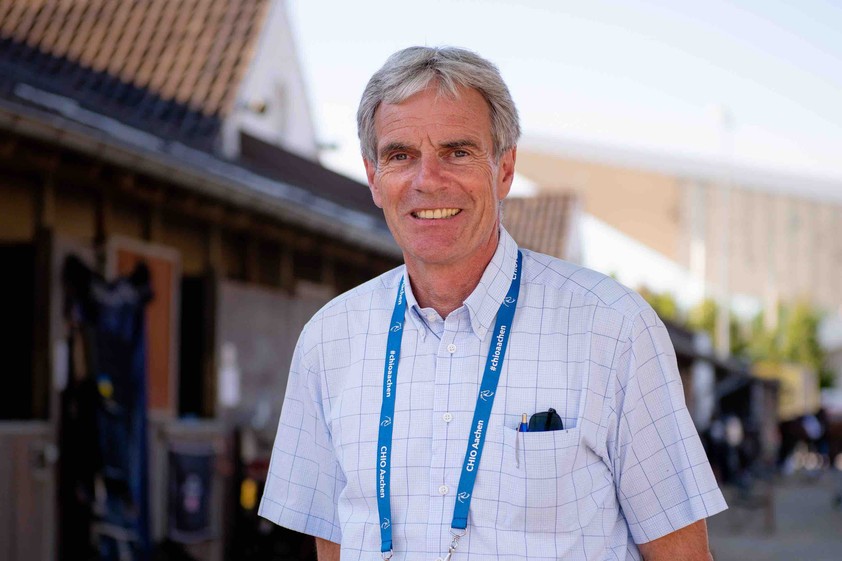Gerrit Nieberg wins the Rolex Grand Prix of Aachen and becomes the Rolex Grand Slam Live Contender
Bathed in glorious July sunshine, CHIO Aachen’s 40,000 capacity Hauptstadion looked resplendent, as it was once again the venue for the 2022 edition of the Rolex Grand Prix, part of the inimitable Rolex Grand Slam of Show Jumping. Comprising 40 starters from 14 nations, including 20 of the world’s top 30-ranked riders, the World Equestrian Festival’s knowledgeable crowd was full of anticipation, ahead of being treated to unparalleled levels of skill and precision from the horse and rider combinations that had qualified for this pinnacle class.
With just the top 18 progressing to the second round, there was little room for error, as the Frank Rothenberger-designed course – consisting of 14 obstacles and 17 efforts – demanded that each pairing was on the very top of their game. Thirteen riders eventually went clear, including on-form McLain Ward, who had his sights firmly set on a hat-trick of victories, having claimed both Wednesday’s and Friday’s showpiece classes. British trio, Harry Charles, Scott Brash and Ben Maher joined the American in round two, alongside five Germans – Gerrit Nieberg, Christian Ahlmann, Daniel Deusser, Mario Stevens and Philipp Weishaupt – much to the delight of the rapturous home crowd. Five advancing riders picked up penalties in the first round and had it all to do, including three-time Major winner, Steve Guerdat, and Harrie Smolders from The Netherlands.
After a short break, while the 12-obstacle second round course was built, two-time Major winner, Philipp Weishaupt got the contest back underway, although an early refusal by his mount Asathir meant there would be no third Major triumph for the German. Eighth to go, America’s McLain Ward and his mount HH Azur was the first combination to go double clear, much to the delight of his team watching on from Aachen’s ‘kiss and cry’ area. Next to go, the current Rolex Grand Slam of Show Jumping Live Contender, Daniel Deusser, and his super mare, Killer Queen Vdm, demonstrated their unwavering talent and ability, recording the contest’s second double clear, thereby triggering a jump-off. The only rider to ever win the Rolex Grand Slam of Show Jumping, Scott Brash soon made it three in the jump-off, after he and Hello Jefferson navigated the 17-effort test fault free. It wasn’t to be for Irish duo Conor Swail and Darragh Kenny, Nayal Nasser of Egypt, Rolex Testimonee Kevin Staut and Great Britain’s Ben Maher, after they all accrued penalties. Penultimate rider to go, Nicola Philippaerts, would become the fourth to contest the jump-off, while last to go, Germany’s Gerrit Nieberg also booked his place in the final showdown.
McLain Ward kicked off proceedings in the jump-off, but was unlucky to put the final fence down. Next up, Daniel Deusser made no mistake, crossing the finishing line without a fault in 41.60 seconds, thereby setting a tough target for the final three riders to try and beat. If anyone could emulate Deusser’s time, Scott Brash could – the 36-year-old Briton going over two seconds faster than his fellow Rolex Testimonee. Despite going clear, Nicola Philippaerts’ slightly slower time saw him slot into third spot. Last to go, current world number 106, Gerrit Nieberg, produced the ride of his life abord his 11-year-old bay gelding, Ben 431, crossing the line over half a second quicker than Brash, thereby winning the 2022 edition of CHIO Aachen’s Rolex Grand Prix and in doing so becoming the new Rolex Grand Slam of Show Jumping Live Contender.
On his victory, winning rider, Gerrit Nieberg, commented: “Everything is still unreal – I really didn’t expect this. Dreams definitely came true today – it was an amazing feeling.
On the winner, second placed Scott Brash, said: “Gerrit did a fantastic round. I knew that there was an inside turn to the double and looked to it when I went in, but I didn’t fancy it and no one else had done it. He [Gerrit] had to do it to win and he did it very well, so all credit to him, and fair play. He rode very, very well and his horse jumped great today.”
On his horse, Hello Jefferson, Scott Brash, said: “I’m extremely proud of Jefferson today, he did an amazing job. I couldn’t have asked any more from him. We were beaten by Gerrit who did an unbelievable round.”
On his mare, Katanga V/H Dingeshof, third placed Nicola Philippaerts, commented: “I’m so proud, you can’t imagine – she’s a very special mare. She gave everything and jumped unbelievably well.”
Rider interview:
Meredith Michaels-Beerbaum
You have had some incredible moments here at CHIO Aachen; do you still get a buzz when you arrive here?
Yes, I must say that when I arrived at the show Thusrday, I got a little teary eyed because I have so many great memories here, and there’s so much emotion. The highest point in my riding career occurred at this venue. There were also some low points in between, where I had to be motivated to come back from disappointment and defeat – there was just so much emotion. It’s a wonderful place and it still makes my heart go pitter-patter.
You’ve achieved some phenomenal successes in the sport; do you now feel a responsibility to give something back and help nurture the next generation of show jumping talent?
Yes. I’m at a different point in my life now, showing less and training more, and I’m very happy to do that because I feel as though I can give something back to the sport, particularly young riders, and particularly women. I think I’ve paved the way for women in this sport, showing them that anything is possible, including being number one in the world, as a woman. And to also make the German team, as a woman, which was dominated by males before I came along. It’s very rewarding for me to be at a different point in my life now and to give something back.
We hear a lot that the Aachen crowd supports riders, whether they win or not. What makes the crowd here so special?
It’s a very special feeling when you walk into the arena and there are 40,000 people clapping for you, all crossing their fingers and wishing you the best. This motivates every rider. It’s an incredible experience to ride here, but to win here in this atmosphere in front of this spectator field is indescribable, it gives you the goosebumps.
Away from show jumping, which other sports are you passionate about? Have you experienced any other major championships?
I’m a great spectator of tennis, but not a great player! Not a great golfer, either, but I’m better at it than I am at tennis. I enjoy watching both of those sports at the top level, and I even had the pleasure of going to Wimbledon, as a Rolex Testimonee, and had the opportunity to meet other Rolex Testimonees. But on the side, I try to improve my golf game.
Do you believe any of your young horses have the potential to become future Grand Prix stars?
We have a few really nice, young horses at the moment. I currently have a horse, who I’m riding, who I’ve been bringing along called I’m Blue, and I think he’s definitely going to make it to Grand Prix level.
How about your students – do any have the potential to be future superstars?
Oh yes – I have some great students at the moment. I have a couple of American students, who are very motivated, just like I was. I have a couple of Chinese students, as well. But my best student is, of course, my daughter, who is motivated and has big dreams, although she’s only 12-years-old, but it’s fun for me to watch her aspire to do great things in the sport.
As you’ve just said, your daughter, Brianne, is a very talented show jumper. Do you believe the Rolex Grand Slam of Show Jumping is inspiring other young talent to pursue careers in the sport?
I think the Rolex Grand Slam of Show Jumping has been a major turning point for the equestrian world. All of a sudden we had Rolex come in, which put a new aspiration, even a pinnacle, on the sport, which other sports, such as tennis and golf have. We finally got to a point where we’re on a similar level with some great sports. It’s been a major achievement, and it’s inspired a lot of people to try and achieve the Rolex dream.
The Vet-Check
Dr. Wilfried Hanbücken
What is your role at CHIO Aachen?
I am the president of the veterinary commission so I am responsible for all veterinary affairs. This requires us to carry out examinations on the horses on arrival to see if they’ve travelled well, that they’ve arrived without any infectious diseases, and that they have no fever. With every horse, we then have to perform a veterinary inspection, which consists of a trot-up to check if the horses are lame or not, to check that the tendons look good, and confirm that the horse’s general attitude is fine. For some disciplines, such as eventing, we sometimes have to do that twice, both before and after cross-country, for example. We also have to view horses’ medication.
It is my responsibility to ensure that there is a good veterinary service provided – a vet in each ring and a vet in the stable area. Here in Aachen, there is a whole team of vets, including specialists in diagnosis and specialists in internal medicine. We are very well equipped – we have ultrasound, endoscopy, we have a complete laboratory here on the showground so that we can deliver a first class service to the horses, especially in cases when a horse is injured or not well. It allows us to manage things on-site and find an early diagnosis. Only in the most severe case, where a surgical intervention is necessary, is a horse then referred to a hospital.
Have you worked on any other international equestrian events?
I have been the foreign veterinary delegate for European and World Championships, and also at the Olympic Games. My stand-out experience came when I was part of the veterinary commission at the London 2012 Olympic Games, which was a fantastic event. It was incredible public relations for all equine sports. I’ve had great times in La Baule, which is a good event. However, the one that I like most is CHIO Aachen. I was born in Aachen and I grew up in Aachen. I’ve work on the show for 40 years – I started as a student supporting the vets, then worked as a vet, then became a member of the veterinary commission, and since 1998 I have been the chef of the veterinary commission.
Over the last 20 years, CHIO Aachen has improved greatly. I believe it was the World Equestrian Games (WEG) in 2006 that really gave us a boost. For me, the event was a huge success, and as far as I’m concerned, there’s never been an equestrian event that has had more positive public attention. Since the WEG, this show has grown – we now have additional disciplines here. Before we just had jumping, dressage and driving – additionally we now have eventing and vaulting.
How important is nutrition for a horse’s wellbeing?
The horse requires nutrition that is adequate for the horse. It needs a large amount of roughage and fibre, which is very important for its gut. If horses are put on a diet with too much grain and not enough fibre then the risk of colic is much higher. You need to give a horse basic good food – there is no superfood. A horse also needs basic good training. From time to time you need to take blood samples to see what a horse might be lacking. In my opinion, supplements are both overrated and overused.
What advice would you give to someone wanting to become an equine vet?
You must have a connection to the horse, have empathy for it, and be eager to learn. If you are only concerned about money, there are other far better opportunities than being an equine vet that you should choose. Our profession has a problem motivating young vets. A lot of aspiring vets have found their way into this profession through their love of the horse, but during their studies they also realise that it’s hard work with long hours, including night and weekend duties. Some then decide that they would like a more comfortable life with more normal hours, with no night duties or weekend working, which is a problem for our industry all across Europe. Maybe it’s just a generation problem.
What is a typical day for you like?
I get up at 7am and I will be at the show at 8.30am, where I will spend the whole day. I’m usually not home before 9pm and sometimes not before 11pm or midnight. And that’s not just for me, that’s for most of the veterinary team. I alone cannot do this job. For example, today there are about 20 vets working here. We start with four vets and as the CHIO progresses the number of vets increase, as the final three days of the Festival are the most intense.
Tell us a little bit about your team…
The WEG in 2006 highlighted that we needed a larger veterinary team, and then we additionally had endurance and reining. In 2002 when we won the bid for the WEG, Frank Kemperman came back from Jerez and said that we had to sit down and make plans. The first plan was to enlarge our facilities in the stables and the veterinary centre, while the second plan was to expand the veterinary team. We then had three years to build the team, so I asked some vets that I knew if they were interested and some others joined spontaneously. The eventual team in 2006 was very well welded together, and the nucleus of that team still exists here today, which I’m very happy about. The team is very supportive of each other, closing their own practices, coming from far and wide across Europe, not just from the local area, but from Belgium, The Netherlands, Austria and all over Germany. Every day I look forward to the show and being here, but it’s always hard work.
When you retire, what legacy would you like to leave in equestrianism?
What I’ve tried to achieve, which has been partially successful, was when the relationship between the official vets and the treating vets improved. The official vets don’t just see themselves as policemen any longer, but also as advisors, and the treating vets are taking this advice. The cooperation of both groups has brought not just a better relationship but also better understanding of the sport, and ultimately a better situation for the horse.
In your opinion, what more can be, and should be, done to improve the welfare of the horse?
There are multiple things that can be done. But for me, the main thing is for the main decisionmakers to ensure that their horses have proper phases of rest, of reduced training and, for certain events, must be specially trained. A horse cannot go through the year on the same level of performance – no horse can sustain that. Most of the good riders that you see here at CHIO Aachen understand that. There must be better controls, whether that’s by improved vet inspections and doping controls, more consistent judging. I still believe that it is still possible to bring the sport on to an even higher level, which is achieved by good horsemanship and ensuring that everything is done for the good of the horse.



